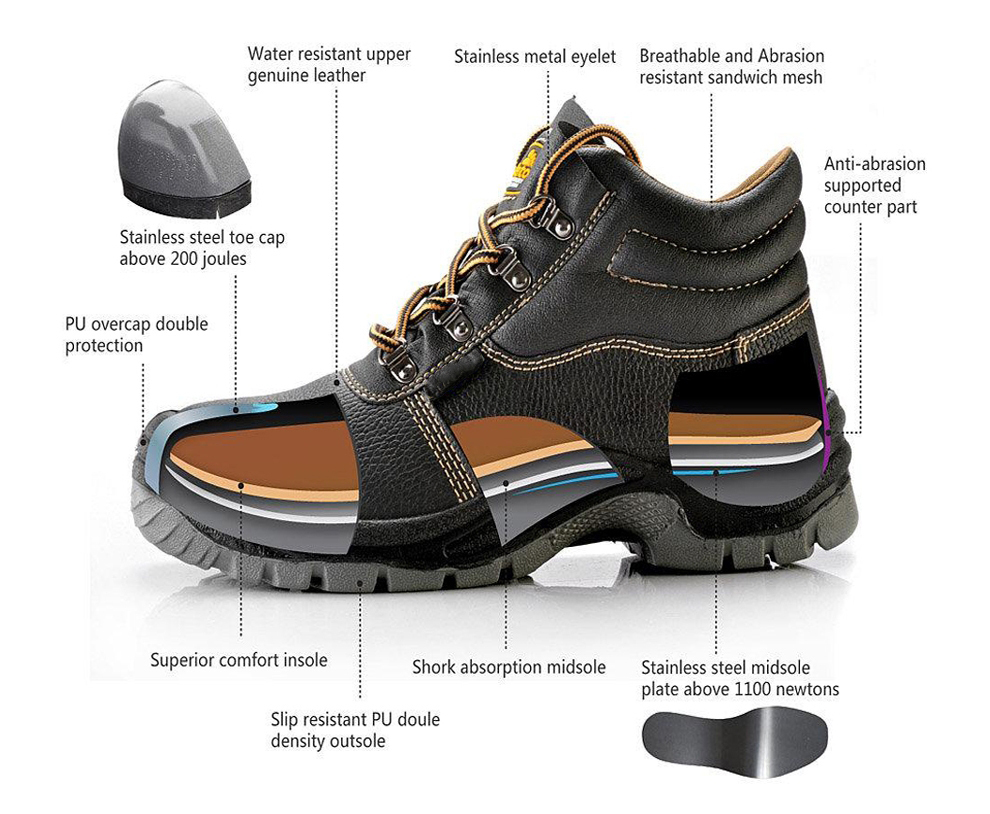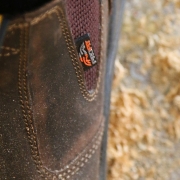ISO 20345 Code For Safety Boots
Q: SANS / ISO 20345? What am I?
A: Safety boot or Safety shoe
This is the International Standards Organisation (ISO) code for footwear that has been approved to avoid risk of injury at work. SANS (South African National Standard) has adopted the ISO marking. All safety footwear sold in South Africa must, mandatorily, have their SANS/ISO accreditation tests and certificates checked and approved by the NRCS (The National Regulator of Compulsory Specifications) who will issue them with a LOA (Letter of Authority) to sell the footwear.
What defines a safety boot?
- 1. A toe cap at the front of the footwear covering your toes. Offering protection of 200 joules of drop or compression protection. It can be made from Steel, Composite (Plastics or Fibre Glass) or Aluminum. Toe caps come in various sizes throughout the styles size range. They also come in a variety of sizes and widths.
- a) What is 200 joules? 20kg of weight dropped from 1.8metres high.
- 2. A thick, abrasion resistant upper covering the entire upper section of the foot. Primarily manufactured out of bovine leather (buffalo or cow). Offering flexibility, breathability, protection from bumps/knocks and scratches – and protection from the elements. It is intrinsically repellent to light splashes of water. (A safety boot is not a gumboot, and no leather safety boot offers 100% water resistance.)
- a) Leather comes in various grades. Simply put… the more expensive the boot or shoe, the better the quality of leather being utilised. Therefore the more superior the thickness, the abrasion resistance and resilience to liquids. The breathability is also superior.
- 3. An outer sole, primarily dual density offering a hard-wearing outsole (in contact with gravel, cement, bricks and stones) and a soft and cushioned midsole (offering a softer, bouncier surface for your foot). It can be made from either PU (Polyurethane), TPU (Thermoplastic Polyurethane) or RB (Rubber).
- a) PU & TPU has a heat resistance of between 90 and 110 degrees. It is anti-static. (Reduces static build up in the body).
- b) Rubber has a heat resistance of 300’ degrees (up to 500’ degrees with certain designs). It is non-conductive (Does not all heat or electricity to flow through)..
- 4. The PU sole compound is resistant to oil, petrol and diesel. The rubber compound has increased resistance to incorporate acids and chemicals as well.
- 5. The outer sole compound also needs to be slip resistant. This can be measured as either a basic SRA slip resistance (soap solution on ceramic tiles) or SRB slip resistance (glycerol on stainless steel) or the superior SRC slip resistance (which covers all slip resistance tests).
- 6. The leather upper is connected to the middle part of the boot through a process called “stroebelling” which is the perpetual angled stitching of the ends of the leather upper to a piece of rigid and anti-static insole board. This is also called innersole. It is the part of the boot your foot will come closest into contact with.
- 7. The boot is not glued to the sole. The boot is not stitched to the sole. The boot is not cemented to the sole. It is held together through a process called direct injection – meaning the outer sole is connected to the leather by liquid polyurethane which hardens around the leather upper. This is what gives safety footwear all of it’s unique characteristics and flexibility of movement.
- 8. Sometime your work environment requires additional protection.
- a) from falling objects which could cause damage to more than just your toes. These falling objects could break the bones in your feet. Boots also come out with meta guards (which over metatarsal protection to those bones on the bridge of your foot)
- b) Or you may work in an area that can cause puncturing through the sole of the footwear and penetrate the underside of your foot. You would then seek out footwear which offers 1100nm (newton metres) of puncture force. This comes in the form of either a steel midplate or an anti-puncture material, like kevlar. The steel midplate is held in place under the insole board. The anti-puncture material takes the place of the insole board.
- 9. Sometimes your work environment only needs a had wearing boot or shoe, that offers all the features of slip resistance and resistance to chemicals but does not need a toe cap. This is called Occupational Footwear. And carries the SANS / ISO 20347 marking. It is not classified as a safety boot or safety shoe.
- 10. Finally, your footwear will either conme standard with or can have an accessory inserted inside it called an insock or a footbed. This is a cushioned and comfortable additional layer of comfort for long hours on one’s feet. It is placed on top of the insole board, or anti puncture material. Normally manufactured from a gel foam or PU injected memory foam. They can be removed and washed. They can also be replaced.

ISO 20345 Safety Boot
—
For a chat about your work forces safety footwear requirements please give us a call on +27 11 892 8030 / 8031 / 8032 or drop an email to organise a call info@profitfootwear.co.za.


